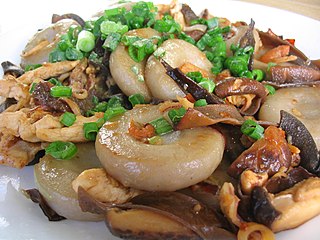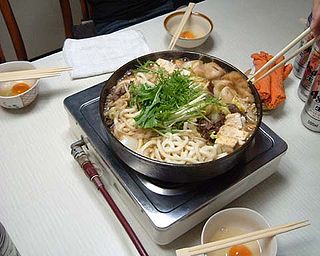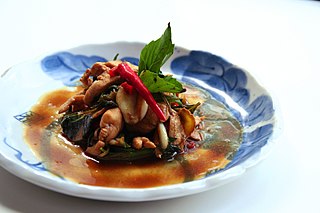| Liaoning cuisine | |||||||
|---|---|---|---|---|---|---|---|
| Traditional Chinese | 遼寧菜 | ||||||
| Simplified Chinese | 辽宁菜 | ||||||
| |||||||
| Part of a series on |
| Chinese cuisine |
|---|
 |
Liaoning cuisine is derived from the native cooking styles of the Liaoning Province in China. It is the most famous Northeastern Chinese cuisine.
| Liaoning cuisine | |||||||
|---|---|---|---|---|---|---|---|
| Traditional Chinese | 遼寧菜 | ||||||
| Simplified Chinese | 辽宁菜 | ||||||
| |||||||
| Part of a series on |
| Chinese cuisine |
|---|
 |
Liaoning cuisine is derived from the native cooking styles of the Liaoning Province in China. It is the most famous Northeastern Chinese cuisine.
The main characteristics of Liaoning cuisine is that it is colorful, tastes are strong, food is soft, and one dish has many flavors/tastes, however, the sweet taste and the salty taste are very distinct.
Some dishes include pickled Chinese cabbage stir-fried with vermicelli, chicken and mushroom stew, lamb kebabs, "malatang" (literally, spicy and hot) soup, stewed chicken with mushrooms, stewed catfish with eggplant, stewed pork with beans, and sliced potatoes with chili.
Since the province shares a border with North Korea, there are dishes similar to Korean cuisine, as well as a large Korean population. The food of Dalian is famed for consuming jellyfish and sea cucumbers by being a coastal city. [1]
| | This section needs expansion. You can help by adding to it. (August 2022) |

Hakka cuisine is the cooking style of the Hakka people, and it may also be found in parts of Taiwan and in countries with significant overseas Hakka communities. There are numerous restaurants in Mainland China, Taiwan, Hong Kong, Indonesia, Malaysia, Singapore, and Thailand serving Hakka cuisine. Hakka cuisine was listed in 2014 on the first Hong Kong Inventory of Intangible Cultural Heritage.

Sichuan cuisine or Sichuanese cuisine, alternatively romanized as Szechwan cuisine or Szechuan cuisine is a style of Chinese cuisine originating from Sichuan province and the neighboring Chongqing municipality. Chongqing was formerly a part of Sichuan until 1997; thus, there is a great deal of cultural overlap between the two administrative divisions. There are many regional, local variations of Sichuanese cuisine within Sichuan and Chongqing.

Nabemono, or simply nabe, is a variety of Japanese hot pot dishes, also known as one pot dishes and "things in a pot".
Sweet and sour is a generic term that encompasses many styles of sauce, cuisine, and cooking methods. It is commonly used in East Asia and Southeast Asia and has been used in England since the Middle Ages. Sweet and sour sauce remains popular in Asian and Western cuisines.

Northeastern Chinese cuisine is a style of Chinese cuisine in Northeast China. While many dishes originated from Shandong cuisine and Manchu cuisine, it is also influenced by the cuisines of Russia, Beijing, Mongolia, and North Korea. It partially relies on preserved foods and large portions due to the region's harsh winters and relatively short growing seasons.

Cellophane noodles, or fensi, sometimes called glass noodles, are a type of transparent noodle made from starch and water. A stabilizer such as chitosan may also be used.

Sanbeiji is a popular chicken dish in Chinese cuisine and one of the most iconic dishes of Jiangxi cuisine. The dish originates from the Jiangxi province of southern China, and is a specialty of Ningdu where the population are Hakka. The dish has become especially popular in Taiwan, being introduced to the island by the Hakka people. It is also served as a postpartum confinement food by the Chinese community of Malaysia. The Jiangxi style has a complex flavor and is spicy, while the Taiwan variant has a more simplistic flavor and is non-spicy.

Yunnan cuisine, alternatively known as Dian cuisine, is an amalgam of the cuisines of the Han Chinese and other ethnic minority groups in Yunnan Province in southwestern China. As the province with the largest number of ethnic minority groups, Yunnan cuisine is vastly varied, and it is difficult to make generalisations. Many Yunnan dishes are quite spicy, and mushrooms are featured prominently. Flowers, ferns, algae and insects may also be eaten. The cuisine of Yunnan is often compared to the cuisine of Southeast Asia as the province borders the region and many of the ethnic minorities or related cultural groups also have a presence in Southeast Asia.

Korean Chinese cuisine, also known as Sino–Korean cuisine, is a hybrid cuisine developed by the ethnic Chinese in Korea.

Chicken feet are cooked and eaten in many countries. After an outer layer of hard skin is removed, most of the edible tissue on the feet consists of skin and tendons, with no muscle. This gives the feet a distinct gelatinous texture different from the rest of the chicken meat.

Indian Chinese cuisine, Chinese Indian cuisine, Sino-Indian cuisine, Chindian cuisine, Hakka Chinese or Desi-Chinese cuisine is a distinct style of Chinese cuisine adapted to Indian tastes, combining Chinese foods with Indian flavours and spices. Though Asian cuisines have mixed throughout history throughout Asia, the most popular origin story of the fusion food resides with Chinese labourers of Calcutta, who immigrated to British Raj India looking for work. Opening restaurant businesses in the area, these early Chinese food sellers adapted their culinary styles to suit Indian tastes.

Japanese Chinese cuisine, also known as chūka, represents a unique fusion of Japanese and Chinese culinary traditions that have evolved over the late 19th century and more recent times. This style, served predominantly by Chinese restaurants in Japan, stands distinct from the "authentic Chinese food" found in areas such as Yokohama Chinatown. Despite this difference, the cuisine retains strong influences from various Chinese culinary styles, as seen in the shippoku cooking style.

Henan or Yu cuisine is an umbrella term used to define the native cooking styles of the Henan province in China. Henan is a province located in Central China and is often also referred to by the names Zhongzhou or Zhongyuan, which means ‘midland’. Being landlocked on all sides, the influence of localized culinary styles are plentiful to be observed in Henan cuisine. It incorporates a blend of culinary styles from Jiangsu and Beijing, which gives it a unique mix of taste. Henan cuisine is well known for its taste variety including a blend of sour, sweet, bitter, spicy and salty. There are a wide variety of Henan dishes, including carp with fried noodles in sweet and sour sauce, grilled head and tail of black carp, Bianjing roasted duck, stewed noodles with mutton, and spicy soup. Despite its mix of flavours within its culinary forms, Henan cuisine is not known to take them to the extreme. Rather, Henan cuisine is known for inducing a very moderate and balanced mix of flavours in its dishes. Henan has a long cultural history, which not only left precious cultural relics and historical sites but also Henan cuisine. Henan cuisine, has the honor of being one of China's oldest and most traditional cooking styles. There are more than 50 kinds of cooking methods in preparing Henan cuisine. The history of the province shows its relation to the affinity towards food culture among the people of Henan, where the motive to bring together the different tastes from the north and the south to blend it into one dish.

Khoresh or Khoresht is a generic Iranian term for stew dishes in the Iranian cuisine, Afghan cuisine, Tajik cuisine and also Kurdish cuisine. The word is a substantive of the verb khordan "to eat" and literally means "meal".

Japanese cuisine has a vast array of regional specialities known as kyōdo ryōri (郷土料理) in Japanese, many of them originating from dishes prepared using local ingredients and traditional recipes.

Manchurian is a class of Indian Chinese dishes made by roughly chopping and deep-frying ingredients such as chicken, cauliflower (gobi), prawns, fish, mutton, and paneer, and then sautéeing them in a sauce flavored with soy sauce. Manchurian is the result of the adaptation of Chinese cooking and seasoning techniques to suit Indian tastes. It has become a staple of Indian Chinese cuisine.

Chinese regional cuisines are amongst the many different cuisines found in different provinces and prefectures of China as well as from larger overseas Chinese communities.

Jilin cuisine is the regional cooking style of the Han Chinese with heavy influence from native Manchu, Korean, and Mongolian minorities in the Jilin Province of Northeastern China.